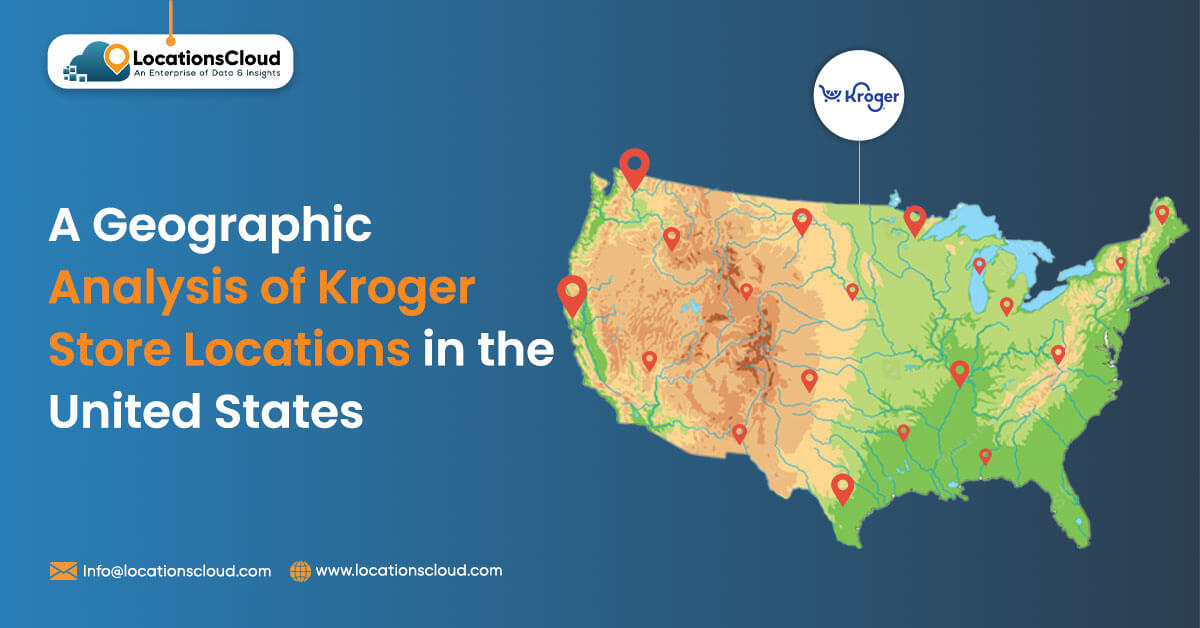
Kroger is one of the successful companies based in America, and it took some considerable time to identify its stores. The retail company evolved and is now called the Kroger Company, encompassing several other formats but, not only grocery retail stores. In its early days, Kroger started its business with Bernard Kroger in 1883 in Cincinnati, Ohio, which is the region from which it originated and operated. This retail store was established in 1883, and it now has more than 2700 stores under the Kroger name. It is spread over 33 states in the USA and Washington, D.C. Besides the conventional grocery stores, it has several facilities, including more than 2200 pharmacies throughout the USA and 225 in-store clinics. Kroger is identified as the largest supermarket retailing company in the United States based on its income and as the fifth largest general merchant.
The Kroger Company is ranked as the largest supermarket retailing company in the United States based on total sales revenue. It is also the fifth-largest general merchandise retailing company in the United States. It also has the distinction of being one of the largest privately held firms in America and one of the largest private sector employers. Further, Kroger stands seventeenth among the largest US corporations according to the Fortune 500, based on total corporate revenue.
SWOT Analysis of Kroger
On October 14, 2022, Kroger announced a merger with Albertsons, creating a new company valued at .6 billion. This merger involves combining Kroger and Albertsons into one entity, but some stores will be sold to C&S Wholesale Grocers to meet regulatory requirements. The deal is expected to be finalized in early 2024. However, in January 2024, Washington state filed a lawsuit to stop the billion-dollar merger, expressing concerns that it could lead to higher prices and harm consumers. In February 2024, Colorado’s Attorney General also filed a lawsuit, citing worries from consumers about potential store closures, price increases, job losses, poorer customer service, and weaker supply chains. Also, in February 2024, the Federal Trade Commission (FTC) endeavored to block the agreement by filing a lawsuit because the movement would negatively impact the wages of workers and prices for consumers.

Strengths:
- Strong brand recognition and customer loyalty
- Extensive store network
- Diverse product range
- Strong financial performance
Weaknesses:
- Intense competition
- US market dependence
- Limited international presence
- Labor issues
Opportunities:
- E-commerce expansion
- Health and wellness focus
- Acquisitions
- International growth
Threats:
- Competition from big-box retailers like Walmart, Target, and Amazon.
- Shifting consumer preferences
- Fluctuations in the US economy
- Regulatory risks, including food safety regulations and labor laws
Brands & Subsidiaries Owned by Kroger
Kroger has stakes in 22 companies, including big brand names such as Harris Teeter, Smith’s Food and Drug, Ralphs, King Soopers/City Market, and Roundy’s supermarkets. These companies are in different fields involving selling merchandise, production companies, and service industries, including hotels.
Harris Teeter is the most profitable of these subsidiaries and records higher revenue than the others. It is also the largest subsidiary in terms of operations and has been expanding more rapidly than the company on average over the last few years. The Kroger Company has a considerable stake in different markets and segments of the economy.
Let’s understand the Subsidiaries and brand run by Kroger:
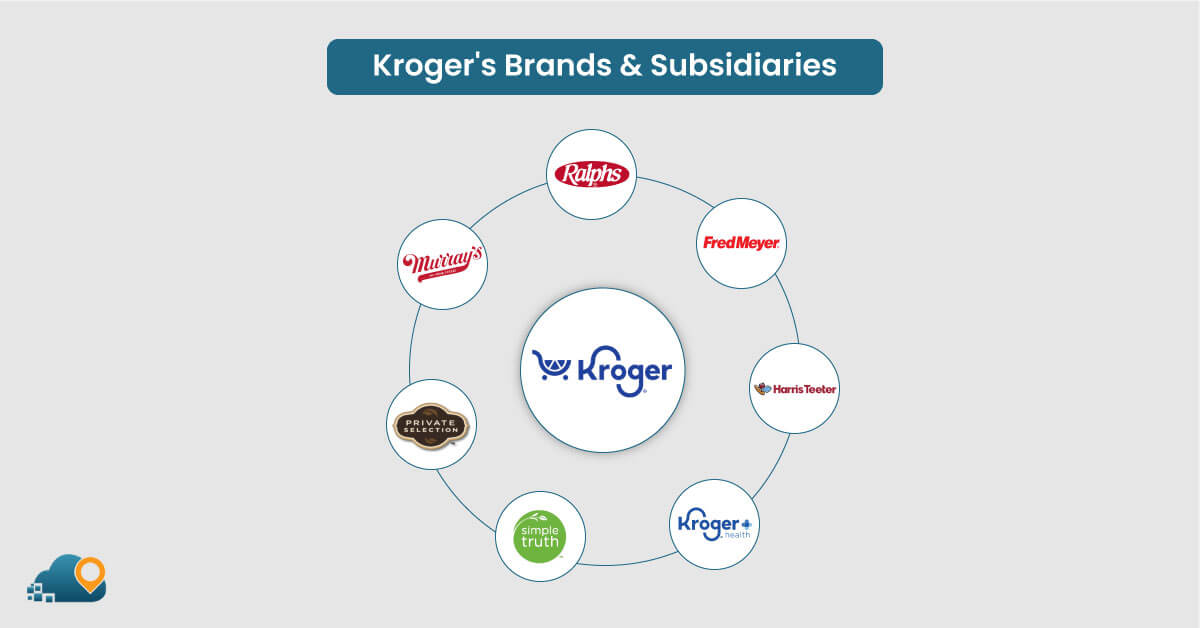
Ralphs: A supermarket chain in Southern California, Ralphs provides groceries, pharmacy services, and other goods.
Fred Meyer: This is a hypermarket retailer chain based in the Pacific Northwest with a product portfolio that includes food, home furnishings, electronics, and other general merchandise.
Harris Teeter is a food supply retailing company located in the Southeastern region of the United States that sells groceries, pharmacy products and services, and related merchandise.
Kroger Health: This subsidiary specializes in delivering health and wellness services such as pharmacy provision, nutrition consultations, and vaccination services.
Simple Truth: This brand belongs to the Kroger Company of America. It focuses on natural and organic products. They sell food and other products like baby, pet, and feminine care products.
Private Selection: Another Kroger brand, Private Selection, offers premium food and drink items such as gourmet snacks and specialty sauces.
Murray’s Cheese: Found in some Kroger stores, Murray’s Cheese offers a wide array of cheeses worldwide.
Kroger: Kroger Ship is another delivery company located in the area. It operates as an online store focused on selling groceries and other household essentials to customers’ doorsteps.
These brands enable Kroger to offer diverse products and services to consumers, allowing this American retailer to demonstrate immense commitment to serving consumer needs in a growing market through innovation.
Revenue Analysis of Kroger Store
Kroger is one of the industry leaders in retail and has demonstrated good financial performance indicators. According to its earnings, the company generates an income of $150,039 million or $150.039 billion per year. This is the total sales revenue that Kroger makes from its sales, and it is arrived at by adding the gross operating profit and sales, general, and administrative expenses.
Kroger’s operating expenses show that the giant supermarket chains company has a net income of $2,164 million (or $2. 164 billion). Net income refers to the sum of money earned by the company for the financial period in question after all direct costs and overheads have been deduchainrom revenues earned by the firm during the period in question.
It also has a large total asset base of $49,623 million (or $49. 623 billion in current economic or market value). Total assets refer to all the assets owned by the company that have some value, such as cash, property, equipment, and supplies, but are not necessarily used in day-to-day activities.
These figures caeted to suggest Kroger’s sound financial position and its large standing in the retail industry.
What is the Total Number of Kroger Stores in the US?
As of May 13, 2024, there are 1,255 Kroger stores spread across the United States. These stores are situated in a total of 593 different cities across 16 states and territories.
Among these locations, Texas stands out with the highest number of Kroger stores, boasting a total of 209 locations. To put this into perspective, approximately 17% of all Kroger stores in the U.S. are concentrated in Texas alone. In simpler terms, nearly one out of every five Kroger stores nationwide is situated within the state of Texas.
This shows the growth and the expansion of Kroger as a company where it has spread its wings in almost all the states of the United States. Kroger is apparently popular and well-known in Texas and other regions where it operates a large number of stores, which makes the company one of the leading players in the retail sector.
Top 10 Territories and States With the Greatest Number of Kroger Stores
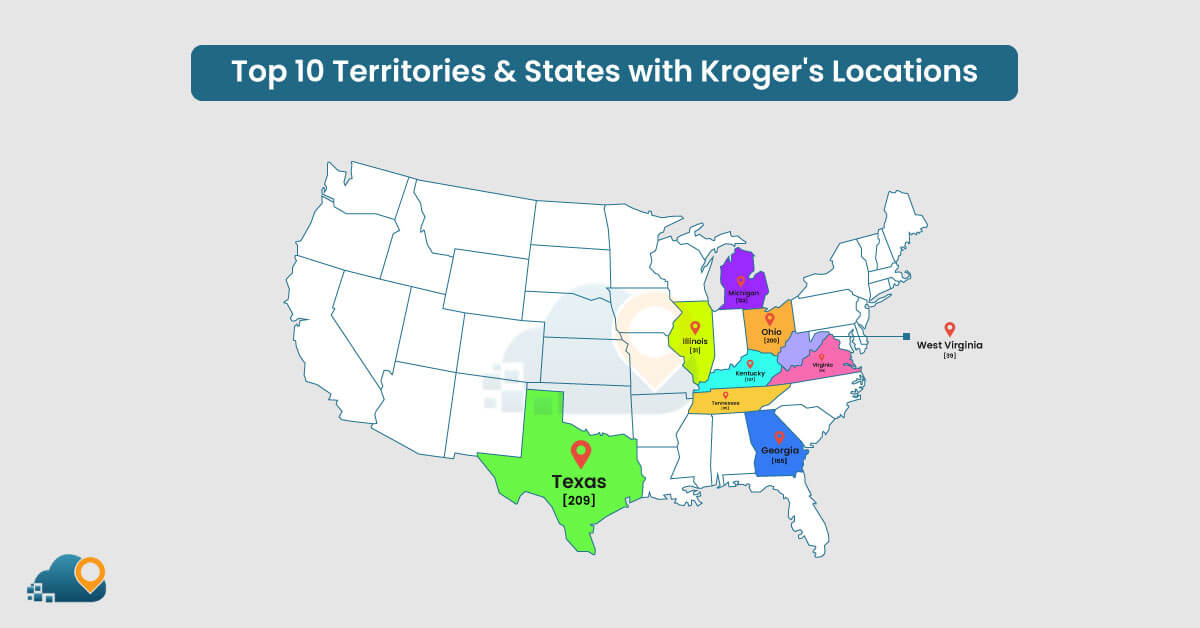
Kroger stores are most concentrated in ten key states and territories in the United States, with Texas leading the way. In Texas, Kroger boasts 209 stores, making up approximately 17% of all Kroger locations in the United States. This translates to roughly one Kroger store for every 138,737 people in Texas. Since it operates a large number of stores, Kroger assures Texans that they can easily get to its shops, which reinforces the company’s hold on the state’s retail space. At the same time, 200 of the 1250 Kroger stores are located in Ohio, which accounts for 16% of all Kroger’s outlets. This creates a higher store density as compared to Texas, whereby one Kroger store is located every 58,445 people in Ohio. This increased accessibility shows that Ohioans have been able to access Kroger’s products and services with a lot of ease.
Similarly, Georgia accommodates 165 Kroger stores, representing around 13% of all Kroger stores in the U.S. With approximately one Kroger store for every 64,345 people, Georgia residents also benefit from convenient access to Kroger’s offerings. Overall, these figures show the strategic positioning of Kroger’s stores to conveniently serve large populations, especially in Texas, Ohio, and Georgia.
Michigan, Tennessee, and Kentucky also feature prominently in the list. Michigan has 122 Kroger stores (10% of the total), with one store per 81,860 people. Tennessee has 119 stores, representing 9% of Kroger’s total, and a population per store ratio of 57,395 people, making it one of the states with the highest Kroger store density. Kentucky, with 107 stores (9% of the total), has the highest store density among these states, with one store for every 41,757 people. Indiana follows with 103 stores (8% of the total), serving a population of 6.73 million, resulting in one store per 65,359 people.
Rounding out the top ten are Virginia, West Virginia, and Illinois. Virginia has 69 Kroger stores (5% of the total), with a population of 8.54 million, equating to one store for every 123,710 people. West Virginia, with 39 stores (3% of the total), has a notably high store density, with one store for every 45,949 people in its population of 1.79 million. Lastly, Illinois has 31 Kroger stores, representing 2% of the total, with a large population of 12.67 million. This means one store for every 408,774 people, the lowest store density among the top ten states and territories.
The American Cities with the Greatest Level of Kroger Stores
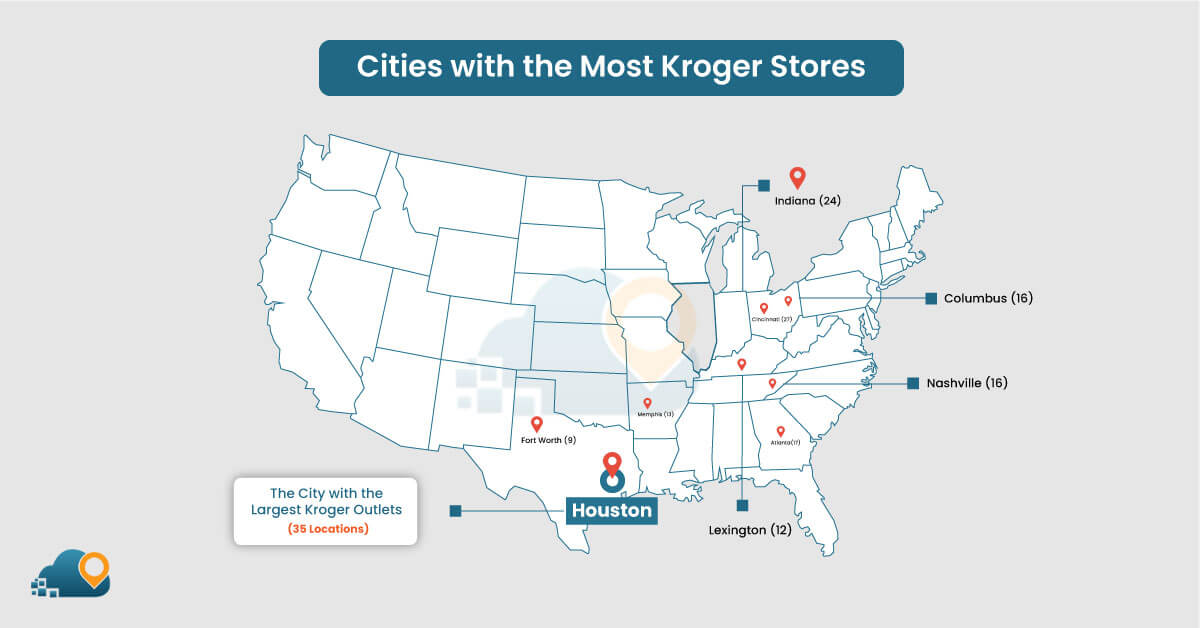
The latest figures of Kroger stores in the United States indicate that Houston, Texas, has the highest Kroger stores at 35. Such a high number of stores can be attributed to the fame of Houston as one of the biggest cities in the United States and the high need for grocery stores in such an urban environment. Next to Houston, the city with the second largest Kroger outlets is Cincinnati, Ohio with 27 stores. Due to its history, Cincinnati already strongly features the Kroger chain as both a place of origination and the corporate headquarters. Louisville, Kentucky, finally, Indianapolis, Indiana has a same number of Kroger stores, namely 24 ones, which proves the potent band existence of such a brand in these large cities.
Some other states with a significant number of Kroger stores are Atlanta-Georgia with 17 outlets, Columbus-Ohio with 16 stores, Nashville-Tennessee with 16 stores. For instance, there are 13 stores in Memphis (Tennessees), while Lexington(Kentucky) has 12. The last on the list is Fort Worth, Texas, with 9Kroger outlets. These are some among the large populated cities where Kroger has stepped into significantly to provide for the populace with its diversified Kroger foods and services.
States and Territories Deprived of Kroger Retail Locations
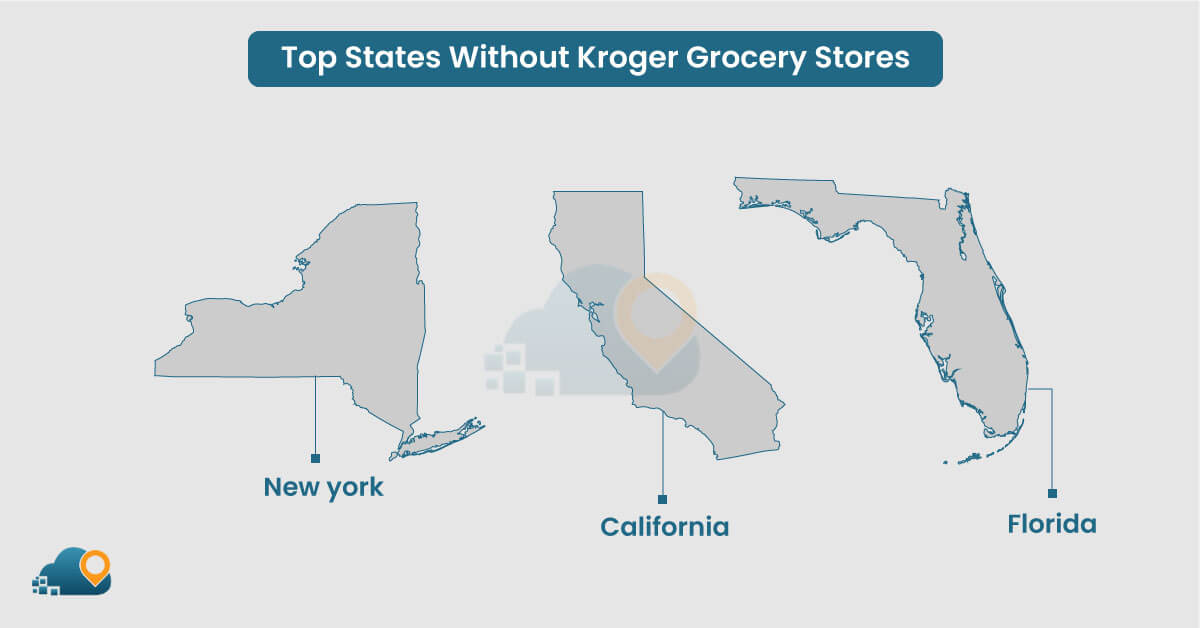
Despite Kroger’s extensive presence across the United States, there are 40 states and territories where you won’t find any Kroger stores. Large and populated regions like New York, California, and Florida are included in a few of these states. Interestingly, despite these states having significant populations and large urban centers, Kroger has not established stores there. Other states without Kroger stores are Kansas, Maine, Rhode Island, and New Mexico, as well as territories like the U.S. US Virgin Islands, Northern Mariana Islands, and Puerto Rico. This lack of success might have several causes, such as local market tactics or competition from other supermarket companies.
Additionally, states like Montana, Delaware, Pennsylvania, and North Dakota also lack Kroger locations. Similarly, you won’t find Kroger stores in Connecticut, Minnesota, Idaho, New Hampshire, Hawaii, and Alaska. The list includes Massachusetts, South Dakota, Nevada, Vermont, Nebraska, Utah, North Carolina, Iowa, Colorado, and Oklahoma. Other areas such as the District of Columbia, Maryland, Wyoming, American Samoa, Washington, Oregon, Guam, New Jersey, and Wisconsin are also without Kroger stores. This wide range of states and territories without Kroger locations highlights the company’s selective market presence and possibly a focus on regions where they can dominate the market more effectively.
Comparison with Kroger’s Competitors and Alternatives
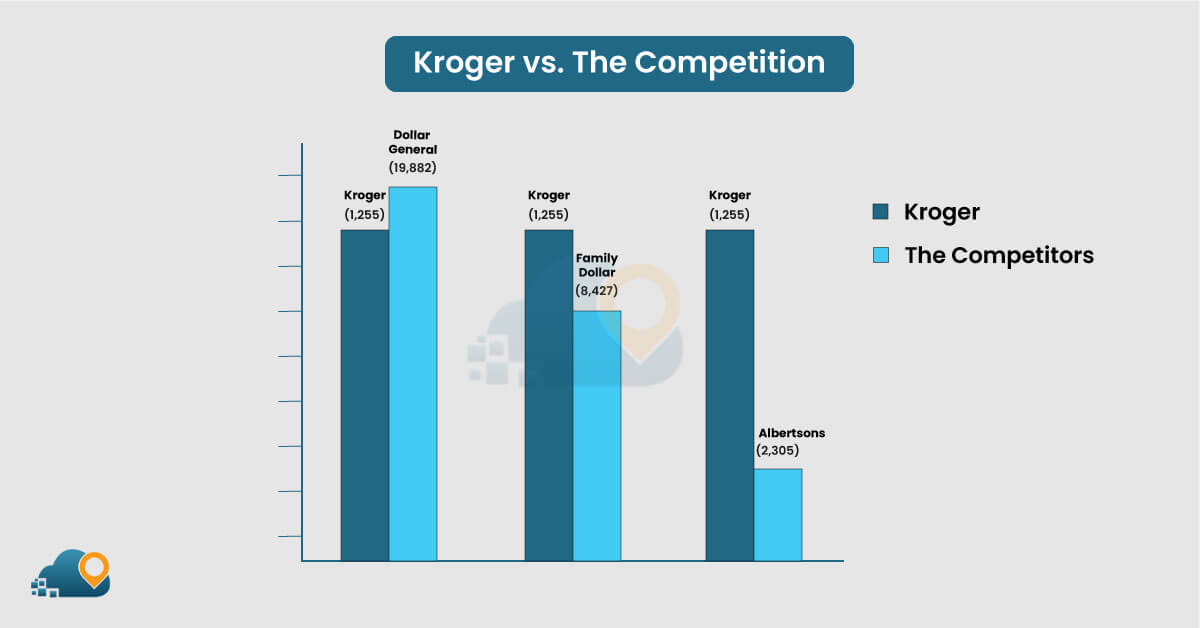
When comparing Kroger to its competitors, Dollar General and Family Dollar have a much more significant presence. Dollar General has 19,882 locations, which is 18,627 more than Kroger. It operates in 48 states, 32 more than Kroger, and has stores in 7,698 cities, which is 7,105 more cities than Kroger. As a result, Dollar General will be able to access a far larger national client base.
Family Dollar also surpasses Kroger with 8,427 locations, 7,172 more than Kroger. Family Dollar operates in 49 states, 33 more than Kroger, and has stores in 3,961 cities, 3,368 more than Kroger. Thanks to its vast network, Family Dollar can service a far greater number of towns than Kroger.
When comparing Kroger to Albertsons Companies, Albertsons has a more prominent presence in several locations, states, and cities. Albertsons has 2,305 locations, which is 1,050 more than Kroger. It operates in 35 states, 19 more than Kroger, and is present in 1,220 cities, 627 more cities than Kroger. This means Albertsons can serve a much wider area and more customers compared to Kroger.
Bottomline
The growing acceptance of digital gadgets and e-commerce is a significant element to consider. Currently, Kroger has been particularly active in these areas, and the trends are predicted to increase even more as more people search for e-shopping. The use digital technology in general and specifically in its stores the key driver of its future success. Competing grocery stores offering similar services whether online or offline is also a central threat. Another idea is that Kroger has to become unique providing great products and offering the top services, as well as creating nothing less than perfect shopping experience for its customers.
This is especially so because people’s tastes and shopping habits constantly shift. There seems to be some trends that Kroger have to follow and adapt to because they make sense. For instance, if a particular segment, such as plant-based or organic food, becomes popular with more people, Kroger may need to adjust its menu to reflect this trend. In sum, it is seen in the case of Kroger that its future is contingent on the extent to which the firm learns and adjusts the identified opportunities, leverages the key strength of the brand, and provides the right brand associations to the customers. Kroger’s marketing strategy is oriented toward the customer. The company aims to make the shopping experience enjoyable, trustworthy, and efficient.


